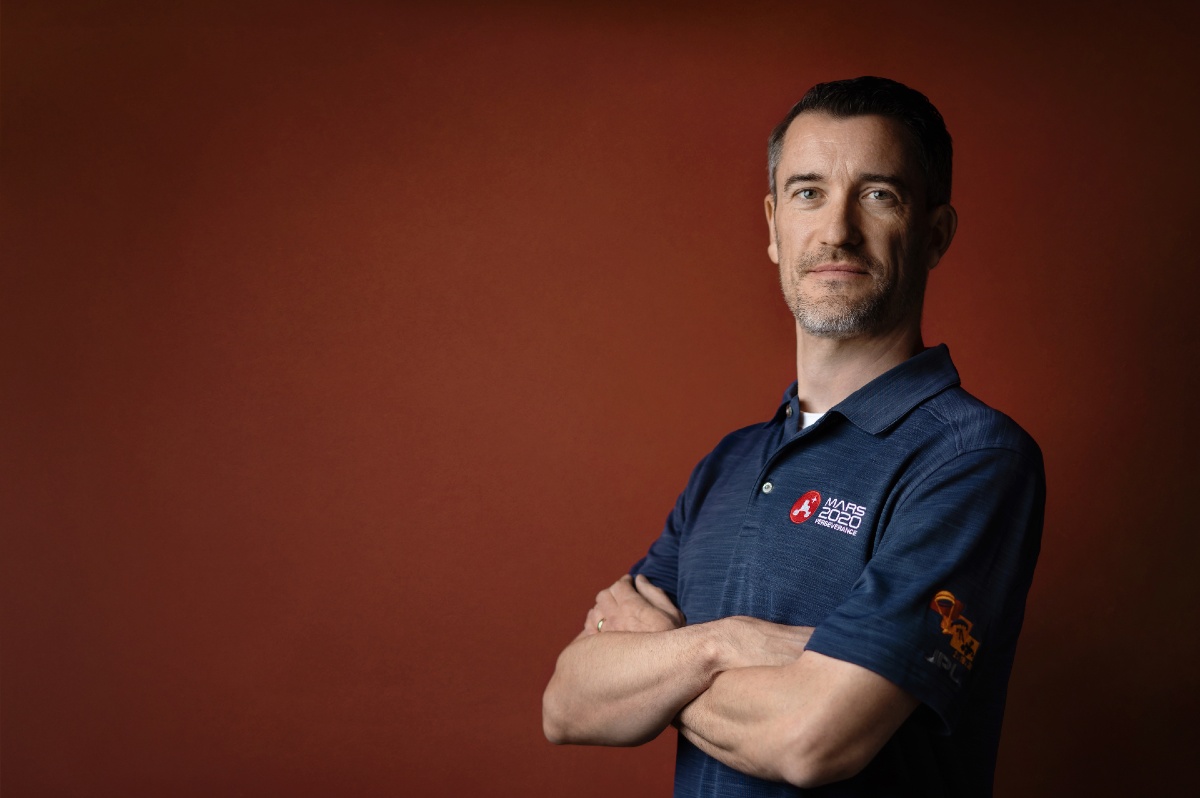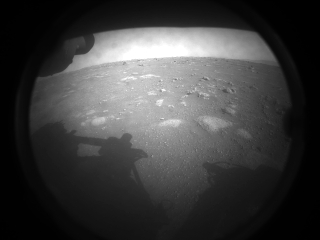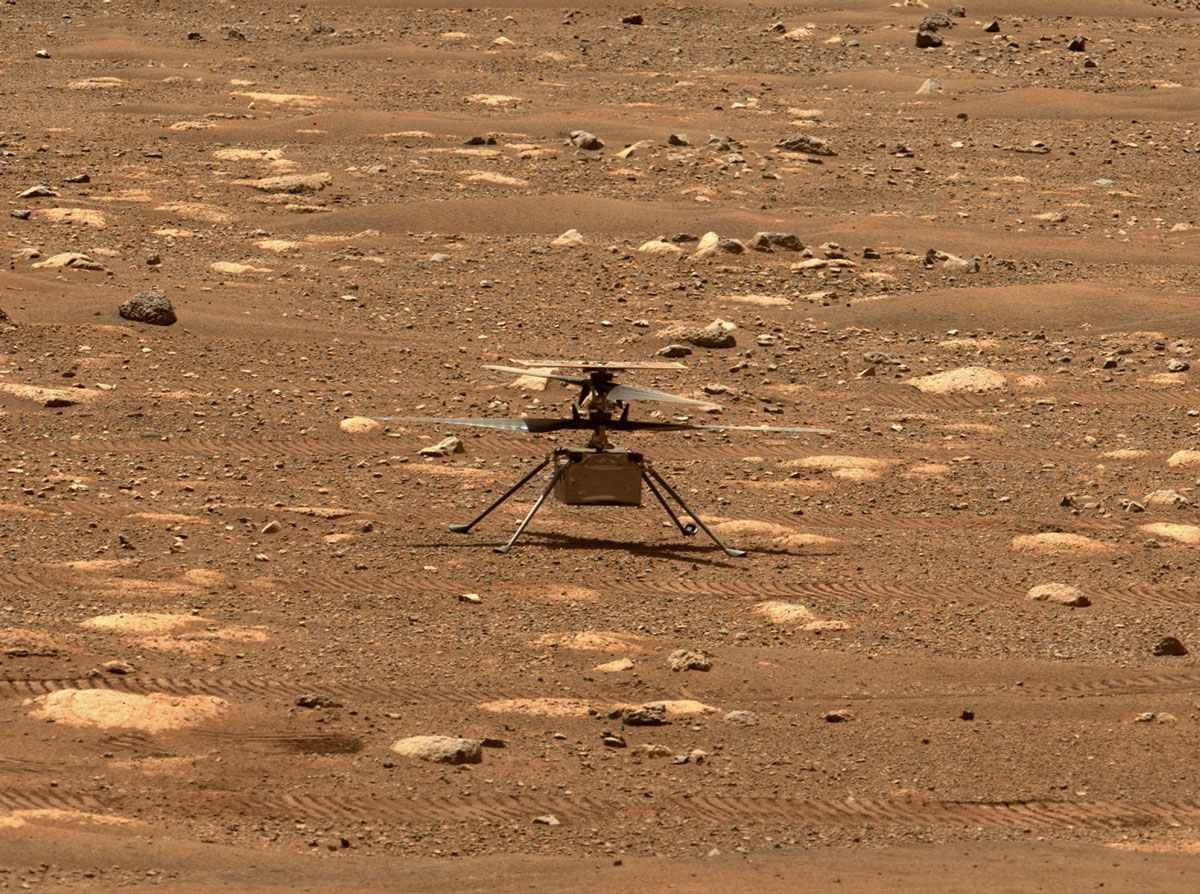A year of Perseverance
Andrew Lyle - 8 July 2021

Chris Herd is part of the Mars 2020 Perseverance rover mission as a returned sample science participating scientist, supported by the Canadian Space Agency. Photo credit: Dawn Graves
One year ago
The morning light glitters off the waves off the coast of Cape Canaveral on July 30, 2020. Less than a kilometre away from the beach, across a pair of access roads and some lush Florida vegetation, Space Launch Complex 41 is abuzz with activity. Towering over the scene is an Atlas V-541 rocket, poised to launch with a precious payload: the Perseverance rover, the star of NASA’s Mars 2020 Rover Mission.
Perseverance has no small challenge ahead. Its mission is to explore the red planet in the hunt for evidence of ancient microbial life. It will provide images and other data from the Martian surface, then carefully gather and cache the most promising samples for a future mission to one day collect them for return to laboratories on Earth. But the entire mission hinges on a successful launch.
It is an emotional morning for many. The world is still gripped by the first wave of the COVID-19 pandemic, and this historic moment for which the mission team has been preparing for years must now take place under strict restrictions. This critical moment—the first of many in the rover’s journey to Mars—is being watched by more than 3.5 million people around the world.
For professor Chris Herd (Earth and atmospheric sciences), it is a particularly tense moment.
“It was one of the most exciting and nerve-racking moments of my life,” says Herd. “Being a part of this mission is a dream come true for me.”
Herd is part of the mission as a returned sample science participating scientist, supported by the Canadian Space Agency, and tasked with helping to select which samples for the rover to gather—those most likely to hold evidence of ancient life and to tell us the most about Mars’ history. As curator of the U of A meteorite collection, his expertise is in the detailed information that we can glean from space rocks, but studying samples carefully acquired from the Martian surface is another prospect altogether.
“The driving question for this mission is ‘Did life ever arise on another planet?’ To answer that question, we cannot rely on the results from instruments on rovers alone—in spite of how advanced those instruments are,” explains Herd. “Perseverance will collect samples from rocks that are inferred to have been formed in environments where life may have existed—for example, the bottom of a crater lake, or along its shore, some 3.5 billion years ago—under the assumption that any life that was there was microbial.

After the harrowing “seven minutes of terror” of landing, the first photo is received from the Perseverance rover on Mars. The image is in black and white so it could be sent as quickly as possible—and is shared via Twitter with a simple message: “Hello, world. My first look at my forever home." Credit: NASA/JPL-CALTECH
“The context provided by the rover's instruments will be essential for interpreting the results of analysis of the samples on Earth. However, we won't be able to tell whether life existed until we get samples back to Earth and can bring the full complement of lab-based studies to bear on the question.”
At 7:50 eastern daylight time, a roar echoes across the beach as the Atlas rocket takes off, and the intrepid rover mission captures the imagination of viewers around the world. Next stop: Jezero Crater, Mars.
Six months ago
Two hundred and three days later, Perseverance begins its final approach to Mars—the most perilous part of its journey. At this distance from Earth, radio signals take 11 minutes to transmit between Perseverance and mission control, and the final landing of the rover must be carried out by onboard computer.
If anything goes wrong during landing, the signal delay means it will be too late to do anything about it by the time mission control learns about it. With Perseverance’s fate out of its hands, the landing phase has earned an ominous nickname: “the seven minutes of terror.”
“Just like with the launch, it was incredibly exciting,” says Herd. “I kept thinking, ‘If anything goes wrong, that changes the entire course of my career over the next several years.’”
Those tense moments in the mission control room were streamed live to viewers around the world. Hushed voices count off checks as the signal comes in from Perseverance. And then, applause.
Amid countless ways things might have gone wrong, Perseverance has deployed its parachute successfully, cut itself loose at the right time, and used its thrusters to slow its descent and land in Jezero Crater. The rover is now broadcasting back to mission control, and a black-and-white photo of the Martian surface is soon shared from Perseverance’s own Twitter account with a simple message: “Hello world. My first look at my forever home.”
Three months ago
A small, nondescript helicopter sits amid rust-coloured dust. Out of context, it might look like someone about to take a drone for a test flight in the Nevada desert. But this little helicopter is about to attempt something that has never been done before.
Ingenuity is a small helicopter deployed from Perseverance. Rotors spinning up in the thin Martian atmosphere, it slowly takes off from the Martian surface, climbs to a height of three metres, lands safely on the ground—and goes down in history as the first powered, controlled flight on another world.
Herd explains that much of April was spent supporting the flying of Ingenuity—a technical demonstration and proof of concept for flight in the atmosphere of another planet.
“But even with that going on, we have been able to continue to explore the rocks nearby, as well as image rocks as far away as over two kilometres,” says Herd. “All of this helps us to better understand the geology of the area, and plan for where to drive and what rocks to investigate, and eventually sample, over the next months and years.”
Today and tomorrow

NASA’s Ingenuity helicopter with its rotorblades unlocked, allowing them to spin freely for the first time since launch. The blades were locked into place during its trip, but here, the helicopter readies to attempt the first powered, controlled flight on another planet, as the Perseverance rover captures images. Credit: NASA/JPL-CALTECH
Mars 2020 is a mission of firsts. It is the first mission to fly on another world, the first to make a recording of the sounds of Mars and the first to prepare samples of Mars to bring back to Earth.
“Our main goal for the near future is to explore the area within a few hundred metres of the landing site, with the intent to return along the same route after we have an idea of the rock types and their relationships to one another, very much like any geological fieldwork done by humans—including geology students—on Earth,” says Herd.
“In the course of that exploration, we will take our first samples. That will be very exciting for me and my fellow returned-sample scientists, and for the whole mission team, since it will represent the first samples collected with the intent to eventually return them to Earth.”
The return of the samples will require another trip to Mars by a future mission, and will require a lander capable of taking off from the planet’s surface and returning to Earth—yet another first.
Those samples will not only hold potential evidence of past microbial life on Mars, they will give planetary geologists a first-hand look at the Martian surface, telling us details about the red planet’s geological composition and history at an unprecedented level. While meteorite fragments of rocks from Mars have been recovered on Earth, when it comes to detailed understanding of Mars’ geologic past, there’s no substitute for running tests on samples hand-selected from the planet’s surface.
“It’s really an honour to be a part of this—it’s absolutely thrilling,” says Herd. “If you had told 13-year-old Chris, who already had decided at that age that he wanted to work on Mars samples when they came back, I think he’d be a pretty excited kid.”